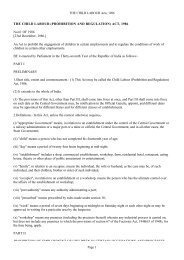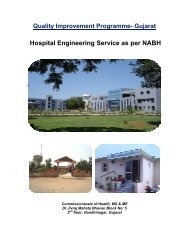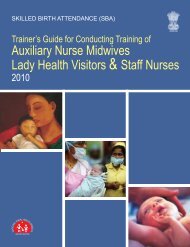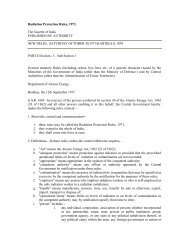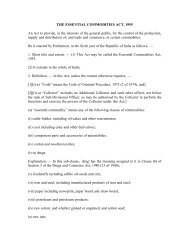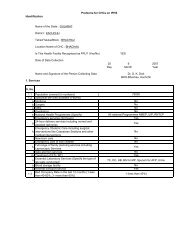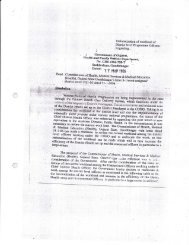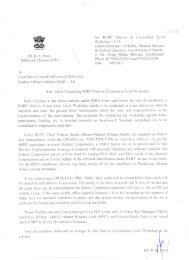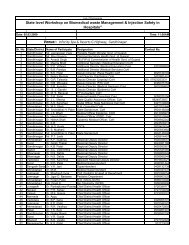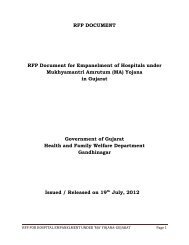Respiratory distress in - Newbornwhocc.org
Respiratory distress in - Newbornwhocc.org
Respiratory distress in - Newbornwhocc.org
You also want an ePaper? Increase the reach of your titles
YUMPU automatically turns print PDFs into web optimized ePapers that Google loves.
NNF Teach<strong>in</strong>g Aids:Newborn Care<br />
shoulders and all babies born through meconium sta<strong>in</strong>ed liquor who are not<br />
vigorous at birth should be <strong>in</strong>tubated and <strong>in</strong>tratracheal suction should be done.<br />
However, vigorous and active babies need not undergo <strong>in</strong>tratracheal<br />
suction<strong>in</strong>g. A vigorous baby is def<strong>in</strong>ed as one who is breath<strong>in</strong>g, has good<br />
muscle tone and heart rate above 100 beats per m<strong>in</strong>ute.<br />
Slide RD-29<br />
Transient tachypnea of newborn (TTNB)<br />
Transient tachypnea of the newborn is a benign condition usually seen <strong>in</strong> term<br />
babies born by cesarean section. These babies are well and have only<br />
tachypnea with rates as high as 80-100/m<strong>in</strong>. The breath<strong>in</strong>g is shallow and<br />
rapid without any significant chest retractions. It occurs because of delayed<br />
clearance of lung fluid. Management is supportive and prognosis is excellent.<br />
Slide RD-30<br />
X ray shows clear lung fields with prom<strong>in</strong>ent right <strong>in</strong>terlobar fissure with<br />
borderl<strong>in</strong>e cardiomegaly suggestive of transient tachypnoea of newborn<br />
(TTNB).<br />
Slide RD-31, 32, 33<br />
Congenital and postnatal pneumonia<br />
In develop<strong>in</strong>g countries, pneumonias account for more than 50 percent cases<br />
of respiratory <strong>distress</strong> <strong>in</strong> newborn. Primary pneumonias are more common<br />
among term or post term <strong>in</strong>fants because of higher <strong>in</strong>cidence of prenatal<br />
aspiration due to fetal hypoxia as a result of placental dysfunction. Preterm<br />
babies may develop pneumonia postnatally as a consequence of septicemia,<br />
aspiration of feeds and ventilation for respiratory failure.<br />
Cl<strong>in</strong>ical picture is characterized by tachypnea, respiratory <strong>distress</strong> with<br />
subcostal retractions, expiratory grunt and cyanosis. The condition may be<br />
heralded by apneic attacks rather than respiratory <strong>distress</strong>. Cough is rare <strong>in</strong> a<br />
newborn baby. The <strong>in</strong>fant with congenital pneumonia is born with follow<strong>in</strong>g<br />
predispos<strong>in</strong>g factors (PROM> 24 hrs, foul smell<strong>in</strong>g liquor, febrile maternal<br />
illness dur<strong>in</strong>g peripartal period, prolonged/difficult delivery; s<strong>in</strong>gle unclean or<br />
multiple vag<strong>in</strong>al exam<strong>in</strong>ation(s) dur<strong>in</strong>g labor). <strong>Respiratory</strong> <strong>distress</strong> is noticed<br />
soon after birth or dur<strong>in</strong>g first 24 hours. Auscultaory signs may be nonspecific.<br />
The newborn may die from pneumonia without manifest<strong>in</strong>g <strong>distress</strong>. Supportive<br />
8




